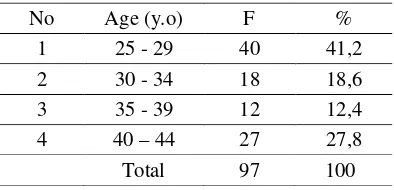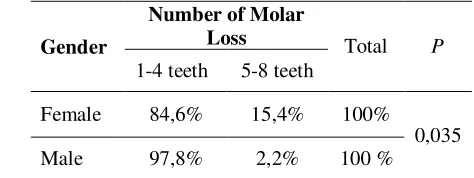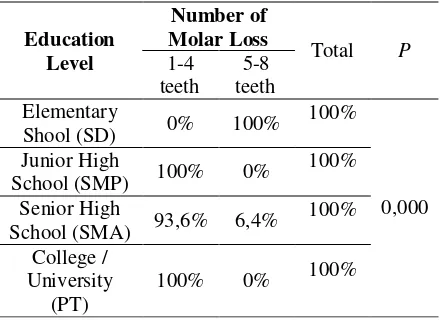THE NUM BER OF M ISSING PERM ANENT M OLAR TEETH BASED ON
CHARACTERISTICS OF RESPONDENT ON LUBUK BUAYA PUBLIC
HEALTH CENTER
M urniwati1, Susi2, Nila Kasum a3, Nilma Raw inda4
1,2,3,4
Facult y of Dent ist ry, Andalas Universit y, Padang, Indonesia
THE NUM BER OF M ISSING PERM ANENT M OLAR TEETH BASED ON
CHARACTERISTICS OF RESPONDENT ON LUBUK BUAYA PUBLIC
HEALTH CENTER
Abstract: Permanent m olar are t he t eet h t hat most ly missing. In Padang, t he Caries Index is 2.78, M issing-Teet h Index is 2.29, M issing Teet h Index percent age is 82.4% w it h 9.2% of dent ure usage. Lubuk Buaya Public Healt h Cent er has t he highest num ber of permanent t oot h ext ract ion in Padang. The purpose of t his st udy is t o look at t he relat ionship of number of missing permanent molar t eet h w it h t he charact erist ics of respondent . The design of t his st udy is using descript ive met hod. The number of samples are 97 respondent s w it h age range bet w een 25-44 years-old, w ho live in Lubuk Buaya Public Healt h Cent er w orking area t hat meet inclusion crit eria. About 90,7% of respondent s lost 1-4 permanent molar w hile 9,3% respondent s lost 5-8 molar. M ost of male (84.6%) and female (97,8%) lost 1-4 molar t eet h. Almost all of age range lost 1-4 molar. All respondent w it h only element ary school level of educat ion lost 5-8 molar t eet h, w hile ot her level of educat ion lost 1-4 molar. Gender, age and t he level of educat ion aff ect t he number of missing perm anent molar t eet h on Lubuk Buaya Public Healt h Cent er w orking area. Low er educat ion level lead t o t he higher number of missing permanent molar t eet h.
Keyw ords: permanent m olar t eet h, charact erist ics of respondent
Introduction
Tooth loss increases with age as a cumulative impact of caries, periodontal disease, and treatment failure or trauma. Nicola et al., stated that permanent molars are the most missing teeth compared with premolars, canines and incisors (Damyanov, 2012).
The impact of losing one permanent molars if it not replaced with dentures are the pathological migration of the adjacent teeth and antagonists, periodontal trauma, interdental caries, loss of contact points due to migration, gingival recession, calculus, and premature occlusion. The mastication function will be disrupted if it loses some permanent molars. If 4 teeth are missing it will cause 8 teeth that are not working for mastication. If the total number of teeth is 32 then 25% of chewing efficiency decreases so that interrupt nutrient intake(Arifzan, 2010). Omar states that the loss of all or most of the molar teeth will have an occlusal impact, decreasing the vertical dimension of the face. If tooth has been loss for a long time period, it may cause interference with Temporomandibular Joint(Omar, 2001).
Basic Health Research (Riskesdas) stated that to achieve the target of health services in 2010, various programs such as promotive, preventive, protective, curative and rehabilitative have been conducted. World Health Organization set indicators, including 5 years old children 90% are caries free, 12 years old children has dental caries damage (DMF-T index) of one tooth, the dental-extraction-free of 18-year-old population (component M = 0), the population aged 35-44 had at least 20 teeth by 90%, the population aged 65 and older still had teeth works by 75%, and people without teeth is ≤ 5%.
only 4.5%. In West Sumatra the DMF-T index is 5.3, M-T 4.3, MTI 81% and the percentage of denture usage is 5.8%. In Padang City, DMF-T index was 2.78, M-T 2.29, MTI 82.4% with percentage of denture usage is 9.2% (Riskesdas, 2007). The most permanent dental extraction from 20 Puskesmas in Padang City in 2011 is the Lubuk Buaya Health Center.
Materials and method
This study describes the number of missing permanent teeth based on the characteristics of respondents, such as gender, age, and education of respondents with descriptive research design. Sampling was done by purposive sampling method. Data were obtained from 97 respondents with age range 25-44 years. The data were collected through interview method by using questionnaire which consisting independent variable (characteristic) and dependent variable (number of permanent molar tooth loss) at Lubuk Buaya Public Health Center from Koto Tangah Sub-district office. To see the relationship of the two variables, Chi-square test was used with p value 0.05.
Results
The frequency distribution of respondents based on characteristic of gender is shown in Table 1.
Table 1 Frequency distribution of respondents based on characteristic of gender
No Gender F %
1 Male 42 43,3
2 Female 55 56,7
Total 97 100
The number of female respondents were more than male respondents.
Distribution of respondent characteristics by age can be seen in Table 2.
Table 2 Distribution of respondent characteristics by age
No Age (y.o) F %
1 25 - 29 40 41,2
2 30 - 34 18 18,6
3 35 - 39 12 12,4
4 40 – 44 27 27,8
Total 97 100
Most of respodents are coming from 25-29 years age group as shown in Table 2.
Table 3 The frequency distribution of respondents based on education level characteristics
The highest education level of most respondents is high school level.
The frequency distribution of the number of permanent tooth loss respondents can be seen in Table 4.
Table 4 Number of Permanent Molar Dental Losses in Community Aged 25-44 y.o. in Lubuk Buaya Public Health Center
Tabel 5 Relation of Gender of Respondent to Number of Molar Teeth Loss
Gender
Tabel 6 Relation of Age of Respondents With Number of Molar Teeth Loss range 30-34 years lost 1-4 permanent molars. Then 7 (25.9%) of respondents with age range 40-44 years lost 5-8 permanent molars. From the results of chi square statistical tests, obtained p value = 0.005, then there is a significant relationship between age with the number of permanent molar tooth loss.
Tabel 7 Relation of Education Level of Respondent with Number of Molar Teeth Loss
Education education with the number of permanent molar tooth loss. The data show that 6 people (100%) of respondents with Elementary School Education level (SD) lost 5-8 permanent molars. While 100% of respondents the level of Junior High School Education level and College level lost 1-4 permanent molars. In the high school education group there were 44 people (93.6%) losing 1-4 permanent molars. From the results of chi square statistical test, it obtained p value = 0.000, p <0.05, then there is a significant relationship between education level with the number of permanent molar tooth loss.
Discussion
are extracted then there will be a replacement due to eruption in the period of mixed teeth (Hedge, 2011).
Based on the annual report of Padang City Health Office 2014, dental disease is one of 10 most common diseases in the Public Health Centers. People usually comes after the tooth has pulp disorder. This led the ratio of fill and extraction in the city of Padang to 0:28 while the target is 1:1.7
The cause of permanent tooth loss according to research conducted by Montandon (2012) is caries. The molar teeth are the largest and have pits and fissures. This surface is the most sensitive part to caries. The sensitivity of the occlusal surface to caries is due to the morphology of the pits and fissures. Food debris and bacteria will be trapped in a narrow and deep pit and fissure, not allowing toothbrush fibers to be able to clean it so caries will occur in that area.
Based on the result of chi square statistic test, it is obtained that the p value <0,05, this means there is a significant relation between characteristic of respondent with amount of permanent molar tooth loss in Work Area of Lubuk Buaya Health Center.
Respondents of male and female gender have the same pattern which mostly have lost 1-4 permanent molars, as reflected in 44 female respondents (84.6%) and 44 male respondents (97.8%).
Respondents aged 35-44 years who lost 5-8 permanent molars were 8 respondents (88.9%). Respondents aged 30-34 years who lost 1-4 permanent molars were 18 respondents (100%). Respondents aged 25-29 years lost 1-4 permanent molars were 39 respondents (97.5%). This is in line with Agtini research (2010) which states that tooth loss increases in the age group of 35-44 years.9 Permanent molar loss increases with age because permanent molar are the first teeth to erupt so they are often destroyed/decayed and then extracted.
Based on education level, most of the respondents came from high school education level, which is 46 respondents (47,4%). All respondents with elementary school education lost 5-8 tooth. While all respondents with the final education is junior high level and college level, lost 1-4 teeth. This indicate that number of tooth loss is increasing if the final level of education is lower. Higher level of education will lead to higher level of people knowledge about the impact of permanent molar loss. This is because the role of education is to increase knowledge, generate positive traits, and community capacity (Notoadmodjo, 2003). Higher level of education will lead to higher level of people awareness to maintain oral health. If a person maintains good oral hygiene then the amount of tooth loss can be minimized, because the teeth with extraction indication will also be minimized.
Knowledge is essential to the formation of person’s actions, knowledge will affect a person in adopting behavior (Notoatmodjo, 2003). In addition, according to Zaini et al (2002) knowledge is the memory of the material studied, which includes the memory of the material of the facts and complete theories, will be reflected from someone’s actions.
Based on the results of this study, it is found that there is a significant relationship between gender, age and education level of society with the number of permanent molar tooth loss in the Work Area of Publick Health Center Lubuk Buaya.
Conclussion
Acknowledgements
The authors would like to thanks to Andalas University and the Ministry of Research, Technology and Higher Education of Indonesia for all support given to this research.
Reference
Agtini, Magdarina Destri (2010). Percentage of Use of Protesa in Indonesia. Padang. Media Litbang Kesehatan 20 (2), 50
Arifzan, Ratna Hartati (2002). The Role of Permanent First Molar in Orthodontic Treatment. Journal PDGI.
Damyanov, Nicola D, Dick J. Witter, Ewald M. Bronkhorst, Nico H. J Creugers (2012). Dental Status and Assosiated Factors in a Dentate Adult Population in Bulgaria: a Cross Sectional Survei. Hindiawi Publishing Corporation.
Hedge, N, Mitra, AS Shija (2011). Carious First Molar in South Canara Population – An Epidemiological Study. Jida, vol 5, no 11.
Montandon, Andreia ( 2012 ). Prevalence and Reasons for Tooth Loss in a Sample from a Dental Clinic in Brazil.International Journal of Dentistry
Montandon, Andreia ( 2012 ). Prevalence and Reasons for Tooth Loss in a Sample from a Dental Clinic in Brazil.International Journal of Dentistry
Ministry of Health of Indonesia (2008). Basic Health Riset. 2007.
Notoatmodjo, Soekidjo (2003). Health Education. PT Rineka Cipta. Jakarta.
Notoatmodjo, Soekidjo (2010). Health Research Methodology. PT Rineka Cipta, Jakarta.
Omar, Ridwaan (2001). The Evidence for Prosthodontic Treatment Planning for Older, Partially Dentate Patients. Med princ pract 2003;(suppl 1): 33-42
Padang City Health Office (2014). Ministry of Health of Indonesia
WHO, Oral Health. Fact Sheet. Available in http://www.who.int/mediacentre/factsheets/fs318/en


